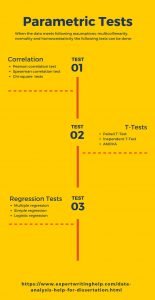How To Choose Statistical Tests To Use in your Dissertation or Capstone Project
Are you a nursing student worried how you will analyze data for your DNP capstone project or dissertation paper? We would like to present to you a comprehensive tutorial on how to choose statistical tests for your dissertation project. In case you get stuck feel free to consult our SPSS data analysis help service
Most people can handle descriptive statistics without issues. But when it comes to inferential statistics, few people exude total confidence. But with the right statistical tests , inferential statistics does get a little easier. This post explains how to choose statistical tests that deliver high-quality findings.
Statistical analysis and testing are somewhat complex but very useful processes. They help researchers and analysts convert tons of raw data into useful information. If you don’t have a grasp of these procedures, you likely won’t see great results.
Before you dive into how to choose statistical tests for your study, study the distribution of your data. You also should spend some time extracting descriptive statistics from the data. In other words, you should calculate the mode, median, and mean. Doing that does make drawing inferences from your data somewhat easier.
What Factors Determine Which Tests You Should Select?
There are a plethora of statistical tests out there. Unsurprisingly, choosing the most fitting statistical test (s) for your research is a daunting task.
Three factors determine the kind of statistical test(s) you should select. These are the nature and distribution of your data, the research design, and the number and type of variables.
Here’s a little general advice on picking statistical tests. If your data is “normally distributed,” it’s best to use parametric tests. But if your data isn’t normally distributed (“non-normal” data), you should go with non-parametric tests.
9 Common Statistical Tests and How to Pick the Right One
Before you pick any particular statistical test, ask yourself: what do I want to do with my data? What do I want to know? After that, pick the statistical test that’s designed specifically to support the execution of that action.
Here’s a list of common statistical tests and what they’re best for so you can pick the best bet for your analysis.
Sign tests
Use the sign statistical test to study the difference between two related variables. This statistical test pays little attention to the magnitude of change in the difference (if any). However, the test factors in the direction of the difference between the variables in question.
Wilcoxon rank sum test
The test focuses on the difference between two variables that are independent of each other. It takes into consideration both the direction and magnitude of the difference between the variables.
Wilcoxon sign rank test
The Wilcoxon sign rank test is used to test the difference between two related variables.
ANOVA
This statistical test helps data analysts to test the difference between group means. Note: You shouldn’t run ANOVA before you’ve accounted for all variances in the outcome variable.
Paired T-test
The Paired T-test helps analyze the difference between the means of two related variables.
Independent T-test
The Independent T-test is the exact opposite of the Paired T-test. This test deepens the analyst’s understanding of the difference between the means of two independent variables.
Pearson correlation test
The Pearson test is a correlational statistical test. It enables you to accurately determine if any statistical association exists between two continuous variables.
Spearman correlation Test
The test is similar to the Pearson correlation test in that it’s a correlational statistical test. The test helps you to describe the association existing between two ordinal variables.
Chi-Square test
The Chi-Square test measures the strength of the association that exists between two categorical variables.
Multiple regression test
The test tracks how change in multiple predictor variables (2 or more) predicts change in the outcome variable.
Single regression test
The test tracks how change in one variable (predictor variable) predicts change in another variable (outcome variable).
You now know what each of 11 common statistical tests measure. At this point, picking the right test for your study should be pretty easy.
Statistical Tests For Inferential Analysis
You’ve learned what various statistical tests do. Which means you can easily know how to choose statistical tests that are suitable for your research. But you probably haven’t mastered any of the tests, have you? Obviously, you can’t leverage the power of any of the statistical tests if you don’t know how they work. Also, you should learn how to use statistical analysis software packages such as SPSS and MATLAB work. That’s because statistical tests and statistical software work hand in hand.
Infographic on how to choose statistical tests
Source: https://www.minds.com/media/939916680893247488
Video on how to choose statistical tests
Source: https://youtu.be/rulIUAN0U3w



 If you’re a data geek, you’re assured of job security, at least for the next one decade. For the last 15 years, there has been an increasing demand for statisticians. According to BLS (The Bureau of Labor Statistics), this growth is not about to relent.
If you’re a data geek, you’re assured of job security, at least for the next one decade. For the last 15 years, there has been an increasing demand for statisticians. According to BLS (The Bureau of Labor Statistics), this growth is not about to relent. Operation research analysis taps into information from every aspect a business: sales data, customer feedback, web analytics, and computer databases. The analysts then use statistical tools to analyze this information and craft solutions for key decision makers.
Operation research analysis taps into information from every aspect a business: sales data, customer feedback, web analytics, and computer databases. The analysts then use statistical tools to analyze this information and craft solutions for key decision makers. A biometrician’s job is to study trends that point to the probability of phenomena or specific conditions occurring. Their findings bolster quality control in field projects as they allow colleagues to anticipate and plan for various scenarios.
A biometrician’s job is to study trends that point to the probability of phenomena or specific conditions occurring. Their findings bolster quality control in field projects as they allow colleagues to anticipate and plan for various scenarios.